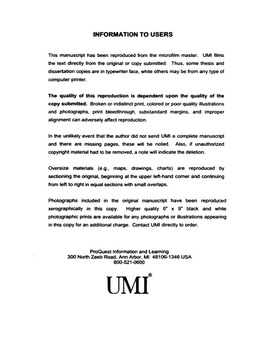| dc.contributor.advisor | Rogers, Michael, | en_US |
| dc.contributor.advisor | Magrath, Jane, | en_US |
| dc.contributor.author | Zdechlik, Lisa Jean. | en_US |
| dc.date.accessioned | 2013-08-16T12:18:26Z | |
| dc.date.available | 2013-08-16T12:18:26Z | |
| dc.date.issued | 2001 | en_US |
| dc.identifier.uri | https://hdl.handle.net/11244/398 | |
| dc.description.abstract | This study examines the textural-fabric of four selected nocturnes of Frederic Chopin from the viewpoint of "sound." The purpose is to convey a deeper understanding of the ways that Chopin expanded the sonorous capabilities of the piano in the nocturnes through his treatment of texture and his innovative use of the damper pedal. | en_US |
| dc.description.abstract | The analysis of each nocturne is presented through four procedures. A parametric profile, comprising melody, rhythm, harmony, form, dynamics, timbre, and articulation, describes each parameter's contribution to the whole of the textural-fabric. The standard textural types---monophonic, homophonic, heterophonic, and polyphonic---describe texture at the surface level; textural setting---voicing, spacing, linear motion, density, and texture-space---describe textural changes at the local level. A graphic representation of selected measures of each nocturne illustrates the whole of the textural-fabric, the vertical and horizontal dimensions of texture, linear relationships, texture-space, dynamics, harmonic rhythmic, and the damper pedal's effect on the fabric of sound. The written analysis synthesizes these individual components of the methodology. How the textural writing creates the sonority of the overall textural-fabric, as well as the damper pedal's role in creating texture, is examined in detail. | en_US |
| dc.description.abstract | Chapter 1 includes an introduction to the topic, the rationale and purpose of the study, the design and limitations, and the analytical procedures. Chapter 2 comprises a discussion of theoretical studies and analytical approaches to textural analysis, as well as a review of the literature surrounding textural analysis, the piano, and Frederic Chopin. Chapter 3 examines the compositional climate of the first half of the nineteenth century, emphasizing the emerging compositional styles and genre brought about by the developments in the piano and the damper pedal. The second part of this chapter examines the historical development of the nocturne and the influences on Chopin's nocturne style. Chapters 4 through 7 comprise analyses of the four selected nocturnes of Frederic Chopin: Nocturne in B♭ minor, Op. 9, No. 1; Nocturne in C♯ minor, Op. 27, No. 1; Nocturne in C, Op. 48, No. 1; and Nocturne in E♭ major, Op. 55, No. 2. A summary of the study as well as recommendations for further study is presented in Chapter 8. | en_US |
| dc.format.extent | xii, 279 leaves : | en_US |
| dc.subject | Piano Methods. | en_US |
| dc.subject | Music. | en_US |
| dc.subject | Piano Pedaling. | en_US |
| dc.subject | Chopin, FrÔΩ̜dÔΩ̜ric, 1810-1849. | en_US |
| dc.title | Texture and pedaling in selected nocturnes of Frederic Chopin. | en_US |
| dc.type | Thesis | en_US |
| dc.thesis.degree | D.M.A. | en_US |
| dc.thesis.degreeDiscipline | School of Music | en_US |
| dc.note | Co-Chairs: Jane Magrath; Michael Rogers. | en_US |
| dc.note | Source: Dissertation Abstracts International, Volume: 62-10, Section: A, page: 3237. | en_US |
| ou.identifier | (UMI)AAI3029625 | en_US |
| ou.group | Weitzenhoffer Family College of Fine Arts::School of Music | |
